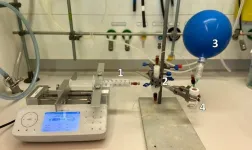(Press-News.org) Challenging long-held beliefs that bird nest building is solely influenced by genetics or the environment, researchers report that the white-browed sparrow weavers of the Kalahari Desert, Africa, build nests with distinct architectural styles that reflect group-specific cultural traditions. “Behavioral traditions in birds have been well documented for song, migration, foraging, and tool use. Here, we add building behavior and show that architectural styles emerge from birds that build together,” write the authors. Humans are well known for their culture-specific architectural traditions. While these cultural traditions are considered a hallmark of human societies, humans are not the only animals to build structures or display cultural traits. A growing body of research shows that animal culture can explain much of the variation observed in behavior. Both variation and conformity in bird nest-building are often thought to be driven by either innate predispositions or environmental factors, with evidence primarily supporting the latter. For instance, birds in colder climates tend to build larger, more insulated nests. However, studies have shown that birds may adjust their nest-building behavior based on previous experience and social learning rather than just responding to environmental conditions. These findings suggest that individual experience, social information, and cultural processes may also play significant roles in the variation observed in avian nest construction.
According to Maria Tello-Ramos and colleagues, white-browed sparrow weavers – social birds that build several single-occupant roosts and nests throughout the year – offer a unique opportunity to study the repeatability and variation in morphology of structures built within and among different groups. Tello-Ramos et al. measured various aspects of nearly 450 structures built by 43 different groups of sparrow weavers across two years in the Kalahari Desert and found that despite living in proximity and having similar genetics and habitat conditions, each group had its own distinct building style. For example, some groups build short, thick structures while others build structures with longer entrances and exit tubes. The findings show that these differences were not influenced by factors like bird size, tree height, or weather and remained consistent even when birds moved between groups, suggesting that migrant birds conform to the building style of their new group. This suggests that social learning and group-specific preferences across generations drive these architectural styles rather than genetics or environmental factors.
END
Cultural traditions, not genetics or environment, inform nest architecture among white-browed sparrow weaver birds
Summary author: Walter Beckwith
2024-08-29
ELSE PRESS RELEASES FROM THIS DATE:
Oxidative damage riggers micronuclear collapse mechanisms in cancer, two studies report
2024-08-29
Reactive oxygen species (ROS) from mitochondria are key drivers of genetic chaos in cancer by causing the collapse of micronuclear envelopes, a process that fuels the chromosomal instability (CIN) often observed in aggressive tumor behavior. These are the findings of two new studies. The findings identify key proteins in this destructive process – p62 and CHMP7 – revealing potential prognostic markers and therapeutic targets for high-CIN tumors. Errors in chromosome segregation during cell division can lead to chromosomal instability, a key feature of cancer. These errors result in the formation of micronuclei, which are small structures ...
Messinian salinity crisis nearly reset Mediterranean biodiversity
2024-08-29
A meta-analysis of Mediterranean Sea marine species reveals the profound impact of the Messinian Salinity Crisis – a drastic environmental event that resulted in the almost complete evaporation of the Mediterranean Sea roughly 5.5 million years ago. According to the new study’s findings, the event nearly reset the region’s biodiversity. The findings offer novel insights linking tectonic and palaeoceanographic changes to marine biodiversity, highlighting the significant role of salt giants in shaping biogeographic patterns, including those that still influence ecosystems today. The Messinian Salinity Crisis (MSC), ...
Uncovering the secret communication of monkeys: They have names!
2024-08-29
New study from Hebrew University reveals that marmoset monkeys use specific calls, known as "phee-calls," to name each other, a behavior previously known to exist only in humans, dolphins, and elephants. This discovery highlights the complexity of social communication in marmosets and suggests that their ability to vocally label each other may provide valuable insights into the evolution of human language.
LINK to pictures https://drive.google.com/drive/folders/1VjzO-70hk27UVX_IuQ6FTsHgmCgk9PCH?usp=drive_link
Credit for pictures and sound: David Omer Lab
In a groundbreaking discovery, researchers from Hebrew ...
Smart mask monitors breath for signs of health
2024-08-29
Personalized wearable devices that monitor people's health are on the rise. From watches to patches and other types of sensors, these smart devices can monitor heart activity, inflammation levels, and more to help patients better manage their health from their own homes. Now, a new type of wearable device can be added to the list: a high-tech paper mask that monitors one's breath.
Caltech's Wei Gao, professor of medical engineering, and his colleagues have developed a ...
Mechanisms of how morphine relieves pain mapped out
2024-08-29
In a study published in Science, researchers at Karolinska Institutet describe the neural processes behind how morphine relieves pain. This is valuable knowledge because the drug has such serious side effects.
Morphine is a powerful painkiller that belongs to the group of opioids. It blocks signals in the pain pathways and also increases feelings of pleasure.
Morphine acts on several central and peripheral pain pathways in the body, but the neural processes behind the pain relief have not previously been fully understood.
Researchers have now investigated how morphine relieves pain using ...
PFAS-free synthesis of fluorinated pharmaceutical and agrochemical compounds
2024-08-29
Chemists at the University of Amsterdam have developed a method to furnish a range of molecules with a trifluoromethyl group attached to a sulphur, nitrogen or oxygen atom. Their procedure, which has just been published in Science, avoids the use of PFAS reagents. It thus provides an environmentally friendly synthesis route for pharmaceutical and agrochemical compounds that rely on the presence of the trifluoromethyl group.
The straightforward and effective method was developed at the Flow Chemistry group at the Van ‘t Hoff Institute for Molecular Sciences ...
School of Dentistry researchers develop innovative sleep apnea model to find answers to chronic pain
2024-08-29
Scientists at The University of Texas Health Science Center at San Antonio (UT Health San Antonio) School of Dentistry created a first of its kind sleep apnea model for studying chronic pain. A study published July 30 in Science Signaling, explains the mechanism behind persistent pain related to obstructive sleep apnea.
More than 100 million people worldwide are affected by obstructive sleep apnea. This health condition causes a person to stop breathing numerous times while they are sleeping. Reduced sleep time and sleep quality can lead to numerous health problems including chronic pain, which is diagnosed at a much higher rate ...
Plastic surgery patients who use marijuana also have elevated nicotine levels
2024-08-29
August 29, 2024 — Marijuana use is common among patients considering plastic surgery and is associated with elevated nicotine levels on laboratory tests, reports a paper in the September issue of Plastic and Reconstructive Surgery®, the official medical journal of the American Society of Plastic Surgeons (ASPS). The journal is published in the Lippincott portfolio by Wolters Kluwer.
"We found that patients who report marijuana use also have elevated urine nicotine and cotinine levels ...
Machine learning predicts which patients will continue taking opioids after hand surgery
2024-08-29
August 29, 2024 — A machine learning algorithm performs well in predicting the risk of persistent opioid use after hand surgery, reports a study in the August issue of Plastic and Reconstructive Surgery®, the official medical journal of the American Society of Plastic Surgeons (ASPS). The journal is published in the Lippincott portfolio by Wolters Kluwer.
"We found that a machine learning model performs well in identifying hand surgery patients who are more likely to become persistent opioid users," comments ASPS ...
$15.5 million NIH award funds development of national network to include nursing home residents in clinical trials
2024-08-29
INDIANAPOLIS – A team led by research scientists from the Indiana University School of Medicine and Regenstrief Institute has received funding expected to total $15.5 million from the National Institutes of Health’s National Institute on Aging to establish a national network structure to include more nursing home residents in clinical trials.
Even though clinical trials are critical to the development and testing of medical therapies and treatments including drugs and care models, individuals living in nursing homes are rarely included in clinical research studies.
The new five-year award will fund ...
LAST 30 PRESS RELEASES:
New study shows how the spleen helps the immune system accept a transplant
New Mayo Clinic study advances personalized prostate cancer education with an EHR-integrated AI agent
Researchers identify novel therapeutic target to improve recovery after nerve injury
Microbes in breast milk help populate infant gut microbiomes
Reprogramming immunity to rewrite the story of Type 1 diabetes
New tool narrows the search for ideal material structures
Artificial saliva containing sugarcane protein helps protect the teeth of patients with head and neck cancer
Understanding the role of linear ubiquitination in T-tubule biogenesis
Researchers identify urban atmosphere as primary reservoir of microplastics
World’s oldest arrow poison – 60,000-year-old traces reveal early advanced hunting techniques
Bristol scientists discover early sponges were soft
New study uncovers how rice viruses manipulate plant defenses to protect insect vectors
NSF–DOE Vera C. Rubin Observatory spots record-breaking asteroid in pre-survey observations
Ribosomal engineering creates “super-probiotic” bacteria
This self-powered eye tracker harnesses energy from blinking and is as comfortable as everyday glasses
Adverse prenatal exposures linked to higher rates of mental health issues, brain changes in adolescents
Restoring mitochondria shows promise for treating chronic nerve pain
Nature study identifies a molecular switch that controls transitions between single-celled and multicellular forms
USU chemists' CRISPR discovery could lead to single diagnostic test for COVID, flu, RSV
Early hominins from Morocco reveal an African lineage near the root of Homo sapiens
Small chimps, big risks: What chimps show us about our own behavior
We finally know how the most common types of planets are created
Thirty-year risk of cardiovascular disease among healthy women according to clinical thresholds of lipoprotein(a)
Yoga for opioid withdrawal and autonomic regulation
Gene therapy ‘switch’ may offer non-addictive pain relief
Study shows your genes determine how fast your DNA mutates with age
Common brain parasite can infect your immune cells. Here's why that's probably OK
International experts connect infections and aging through cellular senescence
An AI–DFT integrated framework accelerates materials discovery and design
Twist to reshape, shift to transform: Bilayer structure enables multifunctional imaging
[Press-News.org] Cultural traditions, not genetics or environment, inform nest architecture among white-browed sparrow weaver birdsSummary author: Walter Beckwith



